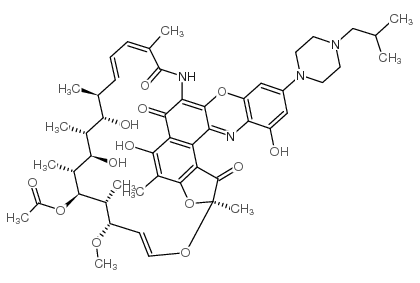| Description |
Rifalazil (KRM-1648; ABI-1648), a rifamycin derivative, inhibits the bacterial DNA-dependent RNA polymerase and kills bacterial cells by blocking off the β-subunit in RNA polymerase[1]. Rifalazil (KRM-1648; ABI-1648) is an antibiotic, exhibits high potency against mycobacteria, gram-positive bacteria, Helicobacter pylori, C. pneumoniae and C. trachomatis with MIC values from 0.00025 to 0.0025 μg/ml[3]. Rifalazil (KRM-1648; ABI-1648) has the potential for the treatment of Chlamydia infection, Clostridium difficile associated diarrhea (CDAD), and tuberculosis (TB)[2].
|
| In Vitro |
Rifalazil exhibits antimicrobal activity against Gram-positive enteric bacteria, inhibits Clostridium difficile, Clostridium perfringens, Bacteroides fragilis with MIC50 value of 0.0015, 0.0039, 0.0313 µg/ml, respectively[3]. Rifalazil exhibits antimicrobal activity against Gram-negative enteric bacteria, inhibits Escherichia coli and Klebsiella pneumoniae with MIC50 value of 16 and 16 µg/ml, respectively[3]. Rifalazil exhibits antimicrobal activity against non-enteric Gram-positive bacteria, inhibits Methicillin-susceptible Staphylococcus aureus, Methicillin-resistant S. aureus, Methicillin- and quinolone-resistant S. aureus, Staphylococcus epidermidis, Streptococcus pyogenes, Streptococcus pneumoniae with MIC50 value of 0.0078, 0.0078, 0.0078, 0.0078, 0.0002, 0.0001 µg/ml, respectively[3]. Rifalazil exhibits antimicrobal activity against Helicobacter pylori, Chlamydia pneumoniae and Chlamydia trachomatis with MIC50 value of 0.004, 0.000125 and 0.00025 µg/ml, respectively[3].
|
